Sirio Gain Master Antenna Review


Vertical base station CB antennas are the most commonly used type of antenna for base installs. Traditionally there has been a large assortment to choose from with many different manufacturers making the claim that their antenna was the best.
The new Sirio Gain-Master has been making some waves in the CB radio world and has many people questioning their previously held beliefs on which antenna was the best vertical on the market. Even Sirio themselves are willing to make the claim that this antenna will out-perform competing antennas.
So here we are today and the gauntlet has been thrown down. We now have the chance to review this new antenna and see if it’s claims are valid and compare it against the popular Imax 2000 in a head to head test.
UNPACKING THE ANTENNA
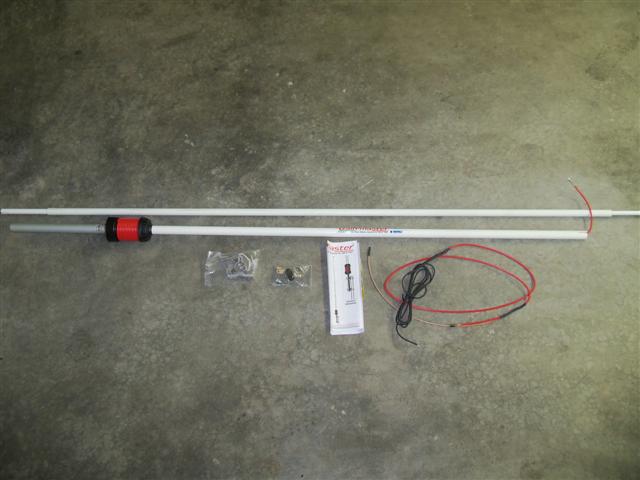
The Sirio Gain-Master will come in a large box 76″ x 5″ x 4″. The parts and pieces inside will consist of the following –
- Main Bottom Section – This piece is the main bottom section of the antenna and has the red choke coil at the bottom.
- Tubing Mast Sections – These are the various length fiberglass sections that will fit together to form the full length antenna.
- Antenna Wire – This is the red/black wiring harness that connects to the bottom section and the wire will run to the very top of the antenna.
- Mounting Hardware.
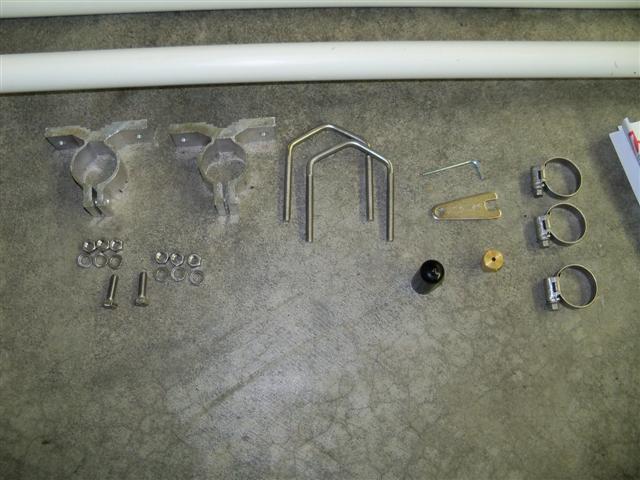
ASSEMBLY
The instructions are fairly straightforward and the assembly is intuitive. You’ll screw the wiring harness connector to the connector coming out of the top of the base section.

In the instructions they do specifically mention not to bend or crimp the wire coming out of the top of the base section but my wire was actually crimped from the factory as in shipping it had been bent over the tubing. I’ve heard from a couple of other people who also found the same thing had happened when they unpacked their antenna. In my case luckily the wire wasn’t compromised and still performed perfectly but it’s something I’d like to see Sirio fix with a little extra packing.
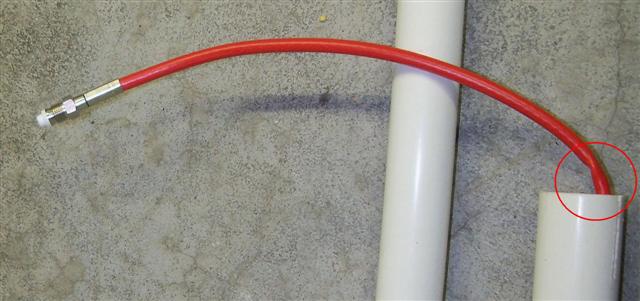
Once you screw the wiring harness to the base section you then can unravel the remaining wire and move to the stage of assembling the antenna sections. You’ll run the main element wire up through the sections of tubing until it pokes out the end. Then you’ll slide the pieces out until the tubing reaches it’s full length.
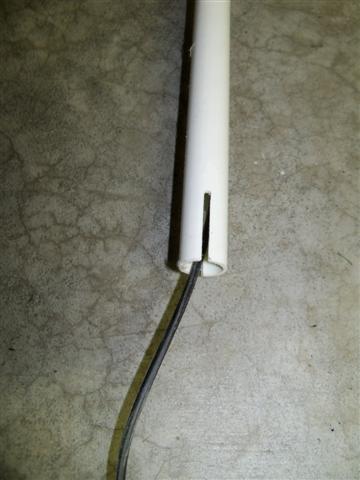
The tubes slide together and are slotted on one end. You’ll apply an included clamp over the slotted section and tighten.

At the very tip of the antenna the wire will stick out and you insert it into an end cap which has a small Allen screw in it. You tighten this screw down on the end of the wire and it secures the wire so it doesn’t fall back down inside the tubing. Add the black rubber cap over the top and you’re done with the assembly.
It may seem a little daunting to those who are used to slapping together 3 piece Imax antennas but it’s very easy and compared to assembling a Yagi or V quad antenna it’s downright simple.
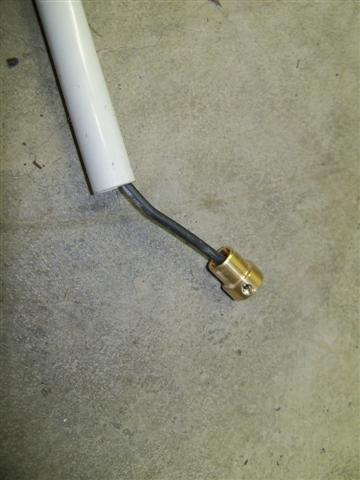
UNIQUE DESIGN ELEMENTS
The Sirio Gain-Master is unique in many ways and is nothing like previous end fed antennas we’ve dealt with in the past. The first thing most people will notice is the large RF Choke located near the bottom of the antenna (Big red coax, you can’t miss it). One of the problems previously recorded with other vertical antennas was that RF would travel down the antenna and interact with the coax, mast, etc creating RF issues in many shacks. The RF choke on the Gain-Master prevents current traveling down the cable shield inside the antenna from going further and interacting with other elements.
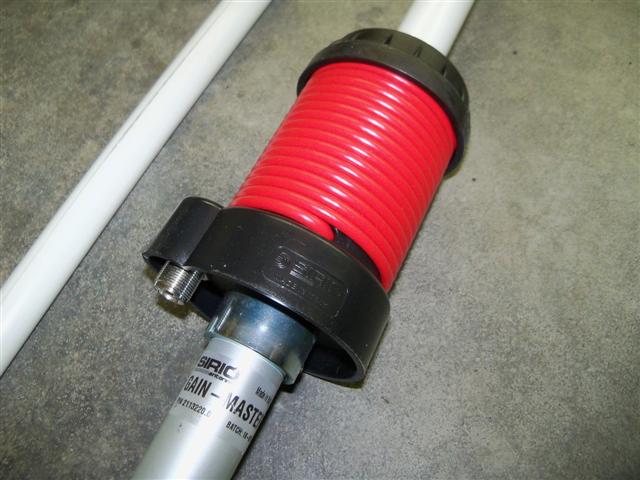
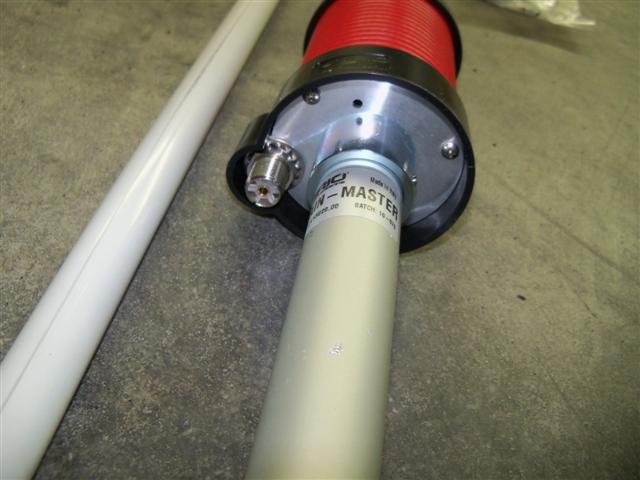
The next part of the antenna is where it gets interesting. While most end fed verticals (A99, Imax 2000) have their matching system at the bottom of the antenna the Gain-Master incorporates a impedance matching stub further up the antenna and even higher up towards the center of the antenna is a capacitor.

Sirio explains this system as follows –

While in other antennas a large amount of loss occurs in the matching network Sirio explains this system as a more balanced design which acts more like a center fed dipole. The result of this more balanced antenna is a more balanced radiated signal.
Sirio explains why they believe this design will outperform conventional 5/8 wave antennas –

INSTALL AND TEST SETUP
We finished assembling the antenna and decided for our testing we would do a direct comparison against an Imax 2000. I assembled my 20 foot mast and first mounted the Imax 2000. Then I would take receiving readings from stations and they would take signal readings on my transmit. Within 5 mins I would lower the mast, unbolt the Imax and mount the Sirio Gain-Master and follow the same procedure. I would then switch back to the Imax 2000 and finally back to the Gain-Master so over the course of the testing to a station I had two chances with each antenna to take reading and account for any local radio wave anomalies that could have effected the results. I also tested with multiple stations on different days. All other parts of the system – coax, radio, power supply, remained exactly the same throughout the testing.
Before I reveal the results of the tests versus the Imax 2000 lets first discuss the performance of the antenna.
TVI
The Imax 2000 I tested did create some issues with an elderly neighbors TV (circa 1985) and I was interested to see if the RF choke on the Sirio would have any effect on her TV as well. I checked with her during testing (luckily she’s radio hobby friendly) and we noted that while both antennas still caused interference with her TV the Sirio registered about half as much interference. Now I think most of the problem with her TV is related to overloading and proximity but I was still interested to see the results. The RF choke on this antenna more likely will help prevent problems with RF local to your shack.
BANDWIDTH
This antenna maintained a SWR below 1.5 from 25.500 MHz to 30.000 MHz which is no small feat. I was able to make contacts on both 10 and 11 meters without difficulty or the need for a tuner.
NOISE
We all know different antennas can pick up different ambient noise and the static level can vary from antenna to antenna based on design, material and polarity. For a vertical antenna the Sirio had a fairly quiet noise level and I would rate it slightly better than the Imax 2000 by a hair. Not much science here since we’re relying in my ears (and I’ve been listening to static for many years).
POWER HANDLING
If this antenna has a Achilles heel it’s the power handling capabilities. The antenna is rated for 500 watts continuous and I’ve already heard of someone who has blown the capacitor on their antenna by running close to 500 watts for longer periods. While this antenna can easily handle the legal limit for CB radios and 10 meter ham radios there are those in the hobby running high power stations that will exceed the limits of this antenna. Keep in mind that for most people this won’t be an issue and to put it in perspective the antenna should be able to handle a 2 x 2879 amplifier (I ran one during testing on multiple occasions without issue).
PERFORMANCE AND COMPARATIVE TESTING
Now it’s time to compare apples and apples. I say this since I was comparing two antennas aimed at the same market with the same type of vertical orientation. However the antennas in design could not be more different and while I would love to test the Sirio against every 5/8 antenna ever made we are limited by time and resources like anything else. So while I believe my testing was fairly comprehensive and we can make some broader assumptions based on the tests we won’t of course make any sweeping claims.
Receive – I made short videos of each station with each antenna and then compared the results. I had local stations give me a AM carrier with no audio. I had stations from 10 miles to 35 miles away in these tests giving me signals to record. In comparison with the Imax 2000 I found no measurable difference in receive signals.
Transmit – This might be the part that you’ve been waiting for in the review. When these antennas first hit the market we started seeing posts on forums that people were claiming these antennas were outperforming their Imax 2000’s and Big Stick type base antennas. A lot of people (myself included) wondering if this new design could really make that much of a difference on the TX side. I hate to see myself as someone to jump on a bandwagon but I’m definitely on board after doing my tests.
In testing with other stations who gave me signal reports based on my AM carrier I found consistently that the Sirio outperformed the Imax 2000 by 0.5 to 1 S units. In my early testing I thought maybe this was just a fluke but again and again the Gain-Master outperformed the Imax on transmit strength at the receiving station. The stronger signal resulted in stations telling me I sounded much louder, easier to understand, clearer, and in one case a station who couldn’t hear me when I was transmitting with the Imax 2000 was able to copy me and carry on a conversation with me when I was using the Gain-Master.
So now I’ll make a slight leap. When I tested the Imax 2000 vs. the Maco V 5/8 on the same setup as the current tests I found the Maco has slightly better receive and transmit (roughly 0.25 S units in both cases). If the Sirio is outperforming the Imax by 0.5 to 1 S unit than we can infer that versus the Maco it would be outperforming on TX by 0.25 – 0.75 S units. Of course we are basing this on past results but all other factors being the same we do have a coarse baseline now established.
Antenna theory, antenna modeling software, scientists and hobby guru’s may all be able to decide which antenna is best without ever touching one but as we all know the best antenna is the one that performs the best for the user in their given application. In that respect for my real world tests at this station I can honestly say that this antenna has definitely turned my head and proven to me that much of the hype we’ve heard is valid. Is this antenna going to outperform every 5/8 on the market – it’s impossible to say but after spending months with this antenna I think it will outperform quite a few favorites out there.
CLAIMS AND DEBATE
Now there has been a lot of debate about this antenna regarding the claims by those who are now running them. I’m going to make my claim that this antenna is roughly equal to the Imax 2000 in receive but outperforms the antenna by 0.5 to 1 S units on transmit. Of course a single claim by one lonely nut ball writer who runs a CB magazine website doesn’t make something fact, but when you start to see multiple claims again and again by people on radio forums you begin to get a general feeling for what to expect from certain products. (The same reason that a product on Amazon with 20,000 positive reviews and 100 negative tends to lend credence that it performs as advertised). When you read enough CB related material online you’ll also will get an idea of what is an overblown claim and what tends to be a more reasonable claim regarding performance.
Over the next couple of years as more people get their hands on these antennas I think the claim that this antenna outperforms many 5/8’s on the market will become generally accepted but until then the discussion and debate will continue.
SUMMARY
It’s not often a vertical antenna can garner as much attention online as the Sirio Gain-Master has in such a short period. I believe this is a testament to the innovation that Sirio is bringing to the market and their continuing effort to create new products and sell more antennas.
The radio hobby can sometimes go through years of boring complacency when everyone runs the same rigs and talks about the same products for month and months. New products that break the mold are one of my favorite things to see and this antenna definitely does just that. A new design that creates better radiated signal, an RF choke to prevent issues inside the shack, and better performance than previous models on the market.
We haven’t yet discussed any negatives about this antenna but I have just one that I can think of and that’s the price, $179.95. This is significantly more than a Imax 2000 ($100-120), or a Maco 5/8 ($125-$135) and so consumers will have to decide if the possible increase in TX signal and the RF choke design is worth the extra $60-$80 in price. For those who plan on setting up a long term station and want to go for the best they can get it may prove that the higher price isn’t an issue. Of course for entry level CBer’s setting up their first time base I think it may be hard for Sirio to lure those buyers away from the Imax.
_________________________________________________________________________________
Where to buy? Amazon – https://amzn.to/2z3p84H
Visit the Sirio Gain-Master website – http://www.gain-master.it/




